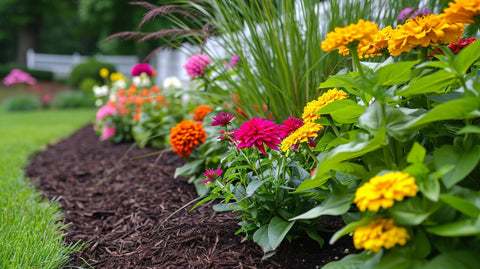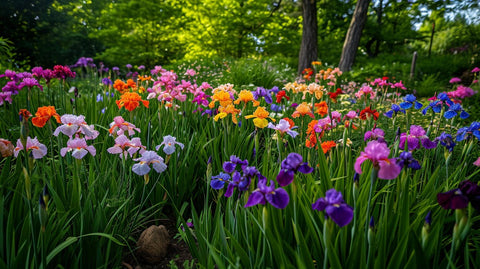Navigation: Introduction | Choosing the Right Flowers for Landscaping | Planning and Designing the Flower Garden | Planting and Maintenance Tips for Landscaping Flowers | Landscaping Flowers for Different Garden Styles | Additional Tips and Inspirations for Landscaping Flowers | Conclusion
Introduction

When it comes to creating beautiful outdoor spaces, landscaping flowers play a vital role in enhancing the overall aesthetic appeal. From vibrant blooms that add color to serene flowers that offer a calming effect, flowers can transform any garden into a picturesque retreat. In this article, we will delve into the importance and benefits of landscaping flowers, and provide valuable insights on choosing the right flowers, planning the flower garden, proper planting techniques, and maintenance tips to ensure your flower garden thrives.
Choosing the Right Flowers for Landscaping
Landscaping flowers should be selected carefully, taking into consideration the climate and local conditions, as well as their compatibility with the existing landscape design.
Considering climate and local conditions
Before diving into the world of flowers, it's crucial to research the flower species that are suitable for your region. Every flower has different temperature, sunlight, and moisture requirements, and selecting the right ones can make all the difference in their survival and flourishing. Additionally, understanding the soil composition and light exposure in your garden will further narrow down your options and ensure successful growth.
Considering the overall landscape design
Harmonizing the colors and shapes of your chosen flowers with the existing elements in your landscape is essential for creating a visually cohesive and appealing garden. By carefully selecting flowers that complement the surroundings, you can achieve a balanced and harmonious look. Furthermore, choosing flowers with varied bloom times will ensure consistent beauty throughout the different seasons.
Planning and Designing the Flower Garden

Successful landscaping starts with proper planning and utilizing the available space and existing features effectively.
Assessing available space and existing features
It's important to begin by measuring the area where you plan to plant the flowers, taking into account any physical limitations or constraints. This initial assessment will enable you to determine the quantity of flowers required and plan the layout accordingly. Additionally, incorporating existing trees, shrubs, or structures into the design can create a seamless transition and add depth to your flower garden.
Creating a focal point or theme
To make your flower garden more enticing, consider creating a focal point or theme. By choosing a central flower bed or key feature, such as an arbor or fountain, you can create visual interest and draw attention to specific areas of your garden. Additionally, opting for a specific color scheme or seasonal theme can further enhance the overall aesthetic appeal and create a cohesive and captivating look.
Planting and Maintenance Tips for Landscaping Flowers
Proper planting techniques and regular maintenance are essential for the health and longevity of your landscape flowers.
Preparing the soil
Before planting, it's crucial to prepare the soil properly. This involves removing any weeds or rocks that may hinder the growth of your flowers. Additionally, you may need to amend the soil with fertilizers or organic matter to improve its quality and provide essential nutrients for your plants' growth.
Planting techniques
When it comes to planting flowers, it is important to follow proper spacing and depth guidelines for each species. This ensures that the plants have enough room to grow without competing for resources. Mulching around the plants and watering them adequately will help retain moisture and promote healthy growth.
Regular maintenance practices
To ensure your flowers continue to thrive, regular maintenance practices are necessary. This includes pruning and deadheading to encourage prolonged blooming and prevent the plants from becoming overgrown. Proper pest and disease management techniques are also important to avoid potential damage to your flowers. Additionally, adjusting watering levels according to the season and specific flower requirements will ensure they receive the right amount of hydration.
Landscaping Flowers for Different Garden Styles

Different garden styles call for specific types of flowers to create the desired aesthetic.
Cottage-style garden
The cottage-style garden is characterized by its romantic and informal atmosphere. For this style, it is best to choose flowers with a variety of colors and combinations to create a vibrant and cheerful look. Roses, peonies, and daisies are popular choices for this garden style. Incorporating pathways or seating areas can further enhance the charm and functionality of this type of garden.
Modern or minimalist garden
A modern or minimalist garden focuses on simplicity and clean lines. Selecting sleek and elegant flower varieties, such as orchids or calla lilies, can help achieve the desired effect. Utilizing bold color contrasts and geometric shapes in the flower arrangements can add visual interest without overwhelming the overall minimalist aesthetic.
Additional Tips and Inspirations for Landscaping Flowers
There are several additional tips and inspirations that can enhance your landscaping flower experience.
Companion planting for natural pest control and pollination
Companion planting involves planting flowers alongside vegetables or herbs to attract beneficial insects for natural pest control and pollination. For example, planting marigolds near tomatoes can deter harmful pests while attracting butterflies and bees to assist with pollination.
Incorporating vertical gardening elements
To maximize space and add a vertical dimension to your garden, consider incorporating vertical gardening elements. This can include trellises, hanging baskets, or vertical planters. By utilizing vertical space, you can showcase a wider variety of flowers and create an eye-catching display.
Utilizing flower containers for limited spaces or mobility
For those with limited spaces or mobility, flower containers can be a great solution. They allow you to create a beautiful flower garden on a smaller scale while providing the flexibility to move or rearrange your flowers as desired. Container gardening also offers the opportunity to experiment with different flower combinations.
Conclusion

Landscaping flowers have the power to transform any outdoor space into a captivating and vibrant haven. By meticulously selecting the right flowers, planning and designing your flower garden, and following proper planting and maintenance techniques, you can create a visually stunning and thriving landscape. Whether you opt for a cottage-style garden with its romantic charm, or a modern and minimalist design with sleek lines, the beauty and benefits of landscaping flowers are undeniable. So, get inspired, unleash your creativity, and start your own flower garden to enjoy the natural beauty that awaits.






























Comments (0)
There are no comments for this article. Be the first one to leave a message!